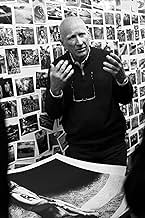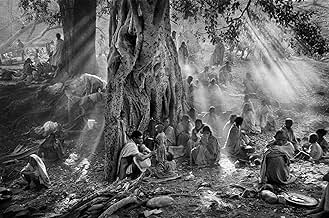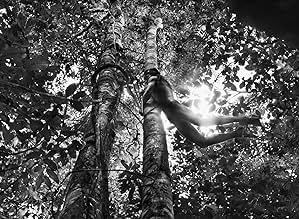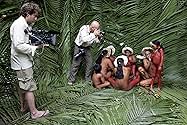IMDb-BEWERTUNG
8,4/10
24.705
IHRE BEWERTUNG
Das Leben und Werk des Fotografen Sebastiao Salgado, der vierzig Jahre damit verbracht hat, in den entlegensten Winkeln der Erde unterprivilegierte Gesellschaften zu dokumentieren.Das Leben und Werk des Fotografen Sebastiao Salgado, der vierzig Jahre damit verbracht hat, in den entlegensten Winkeln der Erde unterprivilegierte Gesellschaften zu dokumentieren.Das Leben und Werk des Fotografen Sebastiao Salgado, der vierzig Jahre damit verbracht hat, in den entlegensten Winkeln der Erde unterprivilegierte Gesellschaften zu dokumentieren.
- Regie
- Drehbuch
- Hauptbesetzung
- Für 1 Oscar nominiert
- 14 Gewinne & 15 Nominierungen insgesamt
Empfohlene Bewertungen
Living in an age where Hollywood seems to believe that churning out CGI-promoted explosion orgies is the only recipe for success, this quiet documentary about the career of Brazilian photographer Sebastião Salgado may disappoint some audiences. Basically you only get to see the Salgado's photos and Salgado's face commenting them and telling the stories that are lurking behind. Most of the movie is made in black and white. The effect could not have been greater. Not only are the viewers stunned by the visual brilliance of the pictures and their monumental qualities but they also learn a lot about the tragedies of famines and genocides that took place in Africa in the 1980s and 1990s. To be honest, these tragedies of unbelievable scope are widely forgotten in the western world. Salgado leads us into the darkest heart of humankind where absolute folly and chaos reign instead of rational judgment. Graduating as an economist, Salgado embarked on a decades-long journey as a photographer, investing all the money of his young family in professional equipment. I think it is unjust to consider him someone who makes his living by showing the misery of mankind, like some reviewer has suggested. If Salgado hadn't been there and clicked his camera, we would not have these photos now which give testimony to what really happened in Africa or Kuwait. Just think about the risks that the young father took on when he was travelling through famine-starved desert or civil war-torn regions! Apart from that, this fine documentary does not leave behind its audience in desperation; Wim Wenders deliberately ends this homage on a harmonious chord by showing a successful reforestation project in Brazil which was initiated by Salgado.
Very touching and beautiful doc about life, love, loss, despair, redemption and it shows how, by sheer faith, you can build a forest. Literally. The beautiful photos tell a troubling yet touching story that will make you angry at mankind. By the end you will find yourself believing again and hoping that one day you could be so humble as to reflect on the negative influences in your life and thus be able to change those nativities into positive reactions . You are probably not doing enough for the world around you and when you see how easy it is to make real change, hopefully it will be a call to action. If a picture tells 1000 words, then this film tells 1000 stories.
The lines on his head were deep as the lines of the earth...
Wim Wenders' new masterpiece is a visually stunning lesson about our planet and our lives. We, the people, are both the salt and the scorch of the Earth...
Juliano Ribeiro Salgado and Wenders have made a thoughtful emotional journey through the life and work of the famous photographer Sebastião Salgado. Both his personal and professional journeys are depicted through the photographs of the talented humanist. The adventurous journey is becoming a discovery of the human nature and after that of nature's condition. A masterful revelation this picturesque travel envisions the marks which we leave on our planet and the traces which we imprint during our stay here.
It is important to note that the overall feeling of this movie is beautifully embodied by the soundtrack as well. And this feeling is surreal - a deep voyage into darkness and light - into the power of drawing with a camera. As a photographer too, I am once again amazed how a single picture can foretell, tell and commit to a certain topic. A person, a landscape, an overall feeling - this is what we get from this film.
Intricately constructed and simplistically presented, the meaning behind these shapes and colors is not ambiguous - we are the spice which could make the Earth both a better and worse place. It is very interesting to see this whole story told in French. I felt a certain feeling mystery and wisdom throughout the whole narrative. And although some scenes were striking, one can only feel humility watching this.
I strongly recommend that every photographer, who is striving to create, should see this movie. This documentary is very much a universal message of the ever repeating cycle of anger - despair - hope. This honorable look at the artist and his power which can transform people and nature is mesmerizing. As a conclusion I truly hope that we can learn from our mistakes and not repeat them all over again. Because when you immerse your soul into the soil, you cannot stay away from the imminent introspection which comes after that...
Wim Wenders' new masterpiece is a visually stunning lesson about our planet and our lives. We, the people, are both the salt and the scorch of the Earth...
Juliano Ribeiro Salgado and Wenders have made a thoughtful emotional journey through the life and work of the famous photographer Sebastião Salgado. Both his personal and professional journeys are depicted through the photographs of the talented humanist. The adventurous journey is becoming a discovery of the human nature and after that of nature's condition. A masterful revelation this picturesque travel envisions the marks which we leave on our planet and the traces which we imprint during our stay here.
It is important to note that the overall feeling of this movie is beautifully embodied by the soundtrack as well. And this feeling is surreal - a deep voyage into darkness and light - into the power of drawing with a camera. As a photographer too, I am once again amazed how a single picture can foretell, tell and commit to a certain topic. A person, a landscape, an overall feeling - this is what we get from this film.
Intricately constructed and simplistically presented, the meaning behind these shapes and colors is not ambiguous - we are the spice which could make the Earth both a better and worse place. It is very interesting to see this whole story told in French. I felt a certain feeling mystery and wisdom throughout the whole narrative. And although some scenes were striking, one can only feel humility watching this.
I strongly recommend that every photographer, who is striving to create, should see this movie. This documentary is very much a universal message of the ever repeating cycle of anger - despair - hope. This honorable look at the artist and his power which can transform people and nature is mesmerizing. As a conclusion I truly hope that we can learn from our mistakes and not repeat them all over again. Because when you immerse your soul into the soil, you cannot stay away from the imminent introspection which comes after that...
"We are a ferocious animal. We humans are terrible animals. Our history is a history of wars. It's an endless story, a tale of madness." – Sebastião Salgado
Directed by Wim Wenders and Juliano Ribeiro Salgado this documentary goes through the life of the photographer Sebastião Salgado, from its childhood times in Minas Gerais until his current role as an activist and founder of Instituto Terra. Not following the typical poetic and metaphorical style, and sometimes pretentious, that characterizes Wim so much, this documentary follows a simple line, however it's not a light viewing. In fact, it's hard, graphic and even chocking in some parts. Divided between the outside interpretations of Wim and Juliano, they reckon their perspectives were complemented with each other's, Juliano as son of Sebastião and Wim as the outside look, admirer of Salgado's work. But it's when Sebastião analyzes its photographs, the highlight of the film, that we realize who he really is and what he testified, transporting us into an incredible journey of anger, despair and hope.
Directed by Wim Wenders and Juliano Ribeiro Salgado this documentary goes through the life of the photographer Sebastião Salgado, from its childhood times in Minas Gerais until his current role as an activist and founder of Instituto Terra. Not following the typical poetic and metaphorical style, and sometimes pretentious, that characterizes Wim so much, this documentary follows a simple line, however it's not a light viewing. In fact, it's hard, graphic and even chocking in some parts. Divided between the outside interpretations of Wim and Juliano, they reckon their perspectives were complemented with each other's, Juliano as son of Sebastião and Wim as the outside look, admirer of Salgado's work. But it's when Sebastião analyzes its photographs, the highlight of the film, that we realize who he really is and what he testified, transporting us into an incredible journey of anger, despair and hope.
10Iwould
Wim Wenders being Wim Wenders, he has nothing left to prove about movie making. So most of this documentary is simply made by the pictures of Sebastião Salgado, and by close-ups of his face: he is looking at the images (but through the screen at the same time), while telling and explaining to the audience the genesis and the reasons of his work. It is very simple, yes, but at the same time it's extremely powerful. So powerful that, after a while, I was under the impression that those still b/w images were alive: crowds in the mass scenes seemed to move, people in portraits looked like they were going to turn their heads, and talk.
This movie should be shown in schools. The work of Salgado has testified some of the major (but lesser known) disasters of recent world history, none of which came within ear of the western world - much more interested in the brilliant lives of the fashion victims than in the tragic fate of the casualties of famines and wars.
Nietzsche famously once wrote: "When you look into the abyss, the abyss also looks into you". Salgado had the guts to stare to the abyss, without blinking - but clicking. He did it to give to others the opportunity to know, and possibly to better understand the meaning of the term "humanity". Some of Sebastião Salgado images are horrible, but it is by far more horrible to think that without him those horrors would have happened with nobody to remember about them. His work creates grounds for memory, and memory grows some chances for hope, and hope give us and some reason to believe in a better future for our troubled planet.
This movie should be shown in schools. The work of Salgado has testified some of the major (but lesser known) disasters of recent world history, none of which came within ear of the western world - much more interested in the brilliant lives of the fashion victims than in the tragic fate of the casualties of famines and wars.
Nietzsche famously once wrote: "When you look into the abyss, the abyss also looks into you". Salgado had the guts to stare to the abyss, without blinking - but clicking. He did it to give to others the opportunity to know, and possibly to better understand the meaning of the term "humanity". Some of Sebastião Salgado images are horrible, but it is by far more horrible to think that without him those horrors would have happened with nobody to remember about them. His work creates grounds for memory, and memory grows some chances for hope, and hope give us and some reason to believe in a better future for our troubled planet.
Wusstest du schon
- WissenswertesThe title of the film is a biblical reference, Matthew 5:13: 'You are the salt of the earth. But if the salt loses its saltiness, how can it be made salty again? It is no longer good for anything, except to be thrown out and trampled underfoot.'
- Zitate
Sebastião Salgado - Photographer: We are a ferocious animal. We humans are terrible animals. Our history is a history of wars. It's an endless story, a tale of madness.
- VerbindungenFeatured in The Oscars (2015)
- SoundtracksThe Salt of the Earth
Written by Laurent Petitgand
Performed by Laurent Petitgand
Top-Auswahl
Melde dich zum Bewerten an und greife auf die Watchlist für personalisierte Empfehlungen zu.
- How long is The Salt of the Earth?Powered by Alexa
Details
- Erscheinungsdatum
- Herkunftsländer
- Offizieller Standort
- Sprachen
- Auch bekannt als
- La sal de la Tierra
- Drehorte
- Yalimo, Papua, Indonesien(Yali tribe)
- Produktionsfirmen
- Weitere beteiligte Unternehmen bei IMDbPro anzeigen
Box Office
- Bruttoertrag in den USA und Kanada
- 1.343.349 $
- Eröffnungswochenende in den USA und in Kanada
- 44.900 $
- 29. März 2015
- Weltweiter Bruttoertrag
- 5.961.567 $
- Laufzeit1 Stunde 50 Minuten
- Farbe
- Sound-Mix
- Seitenverhältnis
- 1.85 : 1
Zu dieser Seite beitragen
Bearbeitung vorschlagen oder fehlenden Inhalt hinzufügen

![Bande-annonce [OV] ansehen](https://m.media-amazon.com/images/M/MV5BMTY0M2ZjMzYtZmJiZC00MDRlLTljNWMtMDRiNmQ1YTgwM2EyXkEyXkFqcGdeQXRyYW5zY29kZS13b3JrZmxvdw@@._V1_QL75_UX500_CR0)


























